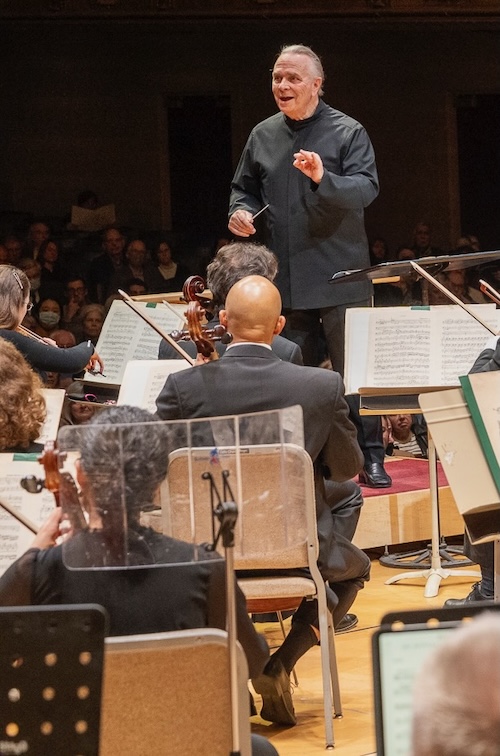In impressive BSO return, Elder leads thrilling Dvořák, lackluster premiere
It’s not unusual for a premiere to be a highlight of a Boston Symphony Orchestra concert. What is out of the ordinary is for the music in question to hail from 1896.
Yet that was the case Thursday night when the BSO and Sir Mark Elder assayed Antonín Dvořák’s The Noonday Witch for the first time at Symphony Hall (the orchestra’s only other performance of the score was a decade ago at Tanglewood). If ever there were a case of “better 130 years late than never,” this was it.
The symphonic poem is based on a harrowing Czech folk tale about a mother who, in an attempt to get her unruly youngster to behave, threatens to summon the eponymous necromancer; the crone appears and, in the ensuing scuffle, the poor woman faints and smothers her child. Despite (or, perhaps, because of) the gloomy subject matter, this is music in which programmatic and thematic content combine with uncommon concision and force.
Thursday’s traversal was appropriately focused and thrilling, marked by bold dynamic contrasts and a strong sense of shape. Elder, back with the BSO after a thirteen-year hiatus, drew playing of winning intensity from his forces–the sarcastic gestures and biting dissonances spoke potently–as well as delicate atmosphere, particularly during The Noonday Witch’s eerie, quiet moments.
Notably, the Dvořák was the evening’s second debut. The first was the American premiere of Elena Langer’s The Dong with a Luminous Nose, a 25-minute-long setting of a poem by Edward Lear for solo cello, chorus, and orchestra.
In her introductory remarks, the Moscow-born, London-based Langer quoted Elder as having jestingly asked her earlier this week what a Russian composer was doing setting a text by the quintessentially Victorian Lear. Considering the merits of the night’s offering, that remains a good question.

BSO principal cello Blaise Déjardin was the soloist in the U.S. premiere of Elena Langer’s The Dong with a Luminous Nose Thursday night. Photo: Michael Lutch
Lear’s 1877 nonsense poem, with its references to “the Gromboolian plain,” “the Chankly Bore,” “Jumblies,” and “the Twangum Tree,” has something of Lewis Carroll, Dr. Seuss, and the Beatles to it; Paul McCartney, no literary slouch, is a Lear admirer. Yet Langer’s setting, which was co-commissioned by the BSO and first heard last year in London, falls flat, lacking any sense of fun, spontaneity, or irony (not to mention a Fab Four-worthy tune or two).
Aside from a sweet coda in which the chorus’s onomatopoetic “dongs” fade into the ether, the composer’s approach to the text is leaden. Too often, the poetic meter acts as an anchor and the music, though it tries, never manages to break free.
Langer’s hybrid structure–part cello concerto, part cantata–doesn’t help things. In fact, the Don Quixote-meets-a-less-bawdy-Carmina burana conceit hardly justifies itself. Outside of a pair of cadenzas, the solo cello writing, though beautifully dispatched Thursday by BSO principal cellist Blaise Déjardin, is undistinguished and often gets subsumed into dense choral-orchestral textures.
The choral part, while effective, is rarely inspired: the vocal lines tend to move either in unison or in blocks and rarely let loose with any counterpoint. Still, the Tanglewood Festival Chorus delivered their role securely, the men enunciating their opening lines cleanly and the larger group blending warmly on the quiet “Far and few” quatrain.
Langer’s fluent and vibrant instrumental writing is the best thing about The Dong. On occasion, it heads in promising directions: the passage that accompanies the onset of the Dong’s madness channels Berg, her scoring for percussion is consistently fresh, and there are some finely dovetailed solos passed between the cello and other members of the orchestra. Even so, the larger work underwhelms.
Regardless, Elder presided over a reading that was a blast of color. Guest concertmaster Nathan Giem made the most of his several solos, especially the lullaby in artificial harmonics near the end, and the audience, perhaps on account of the music’s harmonic accessibility, called the composer back to the stage multiple times.
Elder was in similarly strong form in Maurice Ravel’s complete Mother Goose. Here, the British maestro led the BSO in a reading that was lucid, discreetly textured, and highlighted by woodwind playing that was a picture of pristine ensemble.
The night’s European-style seating of the strings–violins across the podium from one another, violas and cellos in the middle–had the benefit of enhancing the spatial aspect of Ravel’s scoring. Accordingly, the viola and cello solos in the “Prelude” emerged with enchanting naturalness from the heart of the orchestra while the radiant account of the “Apotheosis” was capped by a briefly echoing halo of sound passing through the hall after the cutoff of the last chord.
More good things followed in Leoš Janáček’s Sinfonietta. A wild, five-movement score completed in 1926, it boasts whiplash changes of mood to go along with a massively expanded brass section. In certain hands, the last would likely doom a performance.
Happily, Elder was on the podium and he capably demonstrated that letting the.section loose at the expense of good balance isn’t the only way to go. Rather, a battery of fourteen trumpets–even BSO trumpets–can indeed play well together and not incessantly cover others.
As a result, the Sinfonietta’s outer-movement climaxes were sonically exhilarating but also satisfyingly shaped. Similarly riveting were the bustling figures in the snarky second movement and the Moderato’s impassioned lyrical flights.
The program will be repeated 1:30 p.m. Friday and 8 p.m. Saturday at Symphony Hall. bso.org
Posted in Performances



